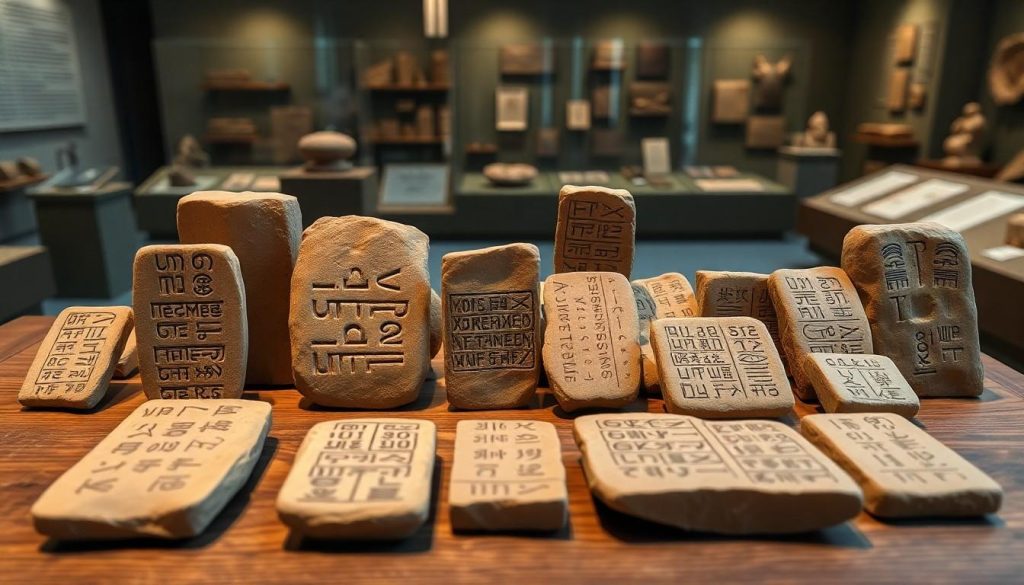Ancient Sumerian tablets are remarkable windows into one of humanity’s earliest civilizations. These clay artifacts, dating back over 5,000 years, reveal fascinating details about daily life, business transactions, and religious practices in ancient Mesopotamia. Through careful preservation and meticulous translation, scholars continue to unlock new insights about this sophisticated society.
The tablets written in cuneiform script represent humanity’s first known writing system. What started as simple pictographs evolved into a complex writing system that recorded everything from astronomical observations to epic poetry. Many of these tablets have survived remarkably well thanks to their durable clay composition and the hot, dry climate of the region where they were discovered.
What Are Sumerian Tablets: An Ancient Writing System
Sumerian tablets represent the earliest form of systematic writing, dating back to approximately 3000 BCE in ancient Mesopotamia. These clay tablets served as the primary medium for recording information using cuneiform script, fundamentally shaping the development of human civilization.
Clay Tablets as Recording Media
The Sumerians crafted their tablets from locally sourced clay, which provided an abundant and practical writing surface. Scribes pressed wedge-shaped marks into the damp clay using reed styluses, creating distinct impressions that hardened into permanent records. The tablets varied in size from 1 inch to 12 inches, depending on their intended purpose:
- Administrative records: Small, palm-sized tablets
- Legal documents: Medium-sized tablets with official seals
- Literary works: Large tablets with multiple columns
- Business transactions: Compact tablets with numerical notations
- Pictographs (3200 BCE): Basic symbol representations
- Phonetic elements (2800 BCE): Signs representing syllables
- Abstract symbols (2600 BCE): Complex combinations for advanced concepts
- Standardized forms (2400 BCE): Unified writing conventions
| Time Period (BCE) | Number of Signs | Primary Uses |
|---|---|---|
| 3200-3000 | 1,000+ | Basic counting, inventory |
| 2800-2600 | 800+ | Administrative records |
| 2600-2400 | 600+ | Literature, legal codes |
| 2400-2000 | 400+ | Multiple languages, royal inscriptions |
The Historical Significance of Sumerian Tablets

Sumerian tablets represent the cornerstone of human written communication, as the development of cuneiform script around 8000 BC made these clay documents the foundation for recording human knowledge exploration across multiple domains.
Economic and Administrative Records
Economic and administrative tablets documented daily transactions through detailed recordkeeping systems. The tablets contain specific information about:
- Trade records listing quantities of goods like oils, fats, livestock
- Payment receipts for services rendered by merchants and artisans
- Inventory counts of temple treasury items, precious metals
- Distribution logs of rations supplies to workers
- Tax collection records from various district settlements
Literary and Religious Texts
The tablets preserved cultural, literary works, and religious practices through carved cuneiform inscriptions. Key elements found in these texts include:
- Epic tales describing heroic deeds, mythological stories
- Hymns and prayers dedicated to various deities, temples
- Religious rituals and ceremonies performed throughout the year
- Poetry collections celebrating cultural achievements and victories
- Educational texts used for training scribes, priests
Each tablet category utilized specialized formatting technical terminology specific to its purpose, demonstrating the sophistication of Sumerian recordkeeping systems. The combination of economic, literary, and religious content provides comprehensive insights into ancient Mesopotamian civilization’s organization and societal structure.
Major Archaeological Discoveries

Archaeological excavations have unearthed significant collections of Sumerian tablets, providing extensive insights into ancient Mesopotamian civilization. These discoveries span multiple sites across modern-day Iraq with varying degrees of preservation.
The Library of Ashurbanipal
The Library of Ashurbanipal, discovered in Nineveh, is history’s oldest known systematic library. This vast collection contains over 30,000 clay tablets assembled under the directive of Assyrian king Ashurbanipal during the 7th century BCE, featuring texts in both Sumerian and Akkadian languages. The tablets document various subjects, including:
- Administrative records detailing palace operations
- Literary works such as the Epic of Gilgamesh
- Scientific texts covering astronomy calculations
- Religious documents containing prayers, hymns
- Medical treatises describing treatments remedies
Nippur Excavation Finds
The excavations at Nippur, the religious center of ancient Sumer, yielded a remarkable collection of tablets from multiple periods. Archaeological teams uncovered:
- Educational texts from ancient scribal schools
- Temple archives documenting religious ceremonies
- Economic records tracking trade merchandise
- Royal inscriptions from various dynasties
- Mathematical tablets showing complex calculations
- Legal documents outlining property disputes
| Site | Number of Tablets | Time Period |
|---|---|---|
| Library of Ashurbanipal | 30,000+ | 7th century BCE |
| Nippur | 15,000+ | 2000-1750 BCE |
The preservation quality of these tablets varies significantly based on storage conditions in archaeological contexts. Many tablets remain in fragmentary states, requiring extensive restoration work to decode their contents. Each new discovery adds additional pieces to understanding ancient Mesopotamian civilization and its cultural practices.
Decoding and Translation Methods

The decoding of Sumerian tablets represents a significant achievement in archaeological linguistics. Early scholars developed systematic approaches to understanding these ancient texts through comparative analysis of multilingual inscriptions.
Evolution of Cuneiform Studies
Georg Friedrich Grotefend’s groundbreaking decipherment of Old Persian cuneiform 1802 established the foundation for understanding the Sumerian script. Scholars like Henry Rawlinson and Edward Hincks utilized trilingual inscriptions containing Old Persian, Babylonian cuneiform, and Elamite text to decode Sumerian characters. The discovery of Akkadian translations provided additional reference points for interpreting Sumerian vocabulary and grammar structures.
- 3D scanning creates high-resolution digital models of tablets, capturing surface details down to individual cuneiform marks
- Machine learning algorithms analyze patterns in cuneiform signs to identify recurring symbols and text structures.
- Online databases store digital copies of tablets, making them accessible to researchers worldwide.
- Digital restoration techniques reconstruct damaged portions of tablets through comparative analysis of similar texts.
- Specialized software tools assist in translating and categorizing cuneiform inscriptions based on established linguistic patterns.
| Digital Preservation Method | Primary Function |
|---|---|
| 3D Scanning | Captures tablet geometry and surface details |
| Machine Learning | Identifies patterns in cuneiform signs |
| Online Databases | Enables global access to tablet collections |
| Digital Restoration | Reconstructs damaged text sections |
| Translation Software | Assists in decoding ancient inscriptions |
Cultural Impact and Legacy
The Sumerian tablets’ cultural impact extends through multiple civilizations, establishing foundational elements of written communication across the ancient Near East. Cuneiform script, developed around 3000 BCE, transformed from essential economic record-keeping into a sophisticated writing system adopted by 15 languages, including Akkadian, Babylonian, and Assyrian.
Literary achievements preserved on these tablets include the Epic of Gilgamesh, recognized as humanity’s earliest surviving literary work. This epic narrative influenced subsequent literary traditions throughout Mesopotamia and beyond, establishing archetypal storytelling patterns in later works.
The widespread adoption of cuneiform writing systems demonstrates the tablets’ significance:
- Linguistic Evolution: Phonetic elements emerged from pictographic origins
- Administrative Systems: Standardized formats for economic records spread across cultures
- Educational Methods: Scribal schools established systematic teaching approaches
- Religious Documentation: Temple rituals recorded in uniform formats
The tablets’ impact on knowledge preservation is evident in these areas:
| Area of Influence | Duration of Use | Number of Languages |
|---|---|---|
| Writing System | 3,000 years | 15 cultures |
| Economic Records | 2,500 years | 12 languages |
| Literary Works | 2,000 years | 8 languages |
Modern archaeological studies continue to reveal the tablets’ influence on:
- Mathematical concepts used in astronomy calculations
- Legal frameworks for commerce transactions
- Architectural planning principles
- Agricultural management techniques
The tablets’ legacy persists through their influence on modern archival systems. They demonstrate humanity’s earliest attempts at systematic information management. Their preservation techniques inform current conservation practices for ancient artifacts, while their content provides insights into the development of human civilization.
Conclusion
Sumerian tablets are remarkable testimonials of humanity’s first steps into written communication. These ancient clay artifacts continue to provide invaluable insights into the birth of civilization through their detailed records of daily life, economic transactions, and cultural practices.
Modern technology has revolutionized how we study and preserve these precious artifacts. Through digital preservation techniques and advanced translation methods, scholars can now more effectively unlock the secrets of these ancient texts.
The legacy of Sumerian tablets extends far beyond their historical significance. They’ve shaped our understanding of human development and continue to influence how we approach knowledge preservation in the digital age. These enduring artifacts remind us that the fundamental human need to record, share, and preserve information remains unchanged across millennia.

